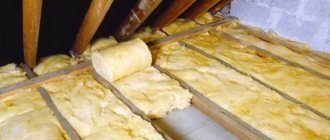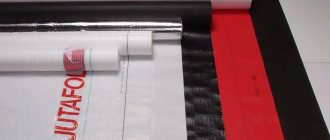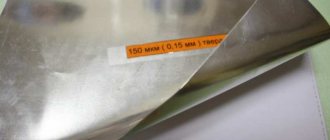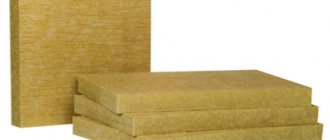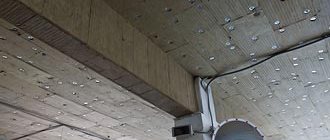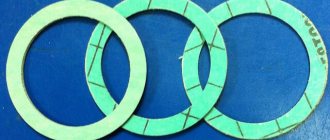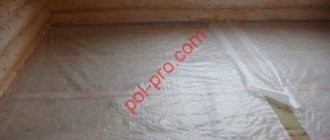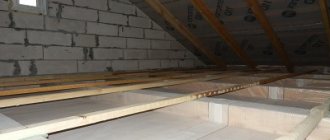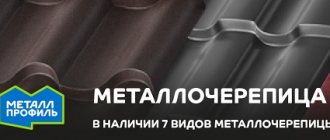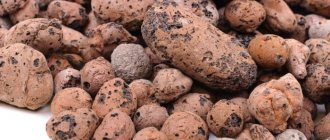In the private sector, wood is still the most popular building material for the construction of various buildings. Blanks for structures are subject to mandatory processing and drying, and also require additional protection. Let's consider which vapor barrier for a wooden ceiling is considered the best solution. Let's get acquainted with the main rules for carrying out installation work and the features of installing an airtight blanket on the ceiling.
Double vapor barrier between the living part of the house and the attic Source pol-exp.com
Purpose of vapor barrier
Many home craftsmen ask whether a vapor barrier is needed on the ceiling. Living in any room leads to a constant increase in humidity levels. This fact is explained by the regular use of water and cooking. As a result of such events, moist steam, which is much lighter than air, rises. If there were no ceilings in the way, the moisture would easily leave the room.
However, this cannot be, therefore excess moisture settles and has a destructive effect on wood, metal, fibrous and porous materials that are directly included in the multilayer structure of any floor. As a result, dampness appears between the materials, which inevitably causes the formation of mold, mildew and rot. Such processes reduce the main operational characteristics of the floor: strength and durability. In addition, the microclimate in the room worsens, unpleasant odors appear, which negatively affects human health.
However, moisture in the room can also form for other reasons. In particular, we are talking about violations of construction technology or mistakes made at the design stage. In this case, the problem is solved using forced ventilation.
The use of vapor barrier membranes helps prevent premature destruction of construction, finishing and thermal insulation materials. The membrane is a material consisting of several layers, each of which is assigned a specific function. Such protection will be quite expensive, so if there is a budget deficit, you can look for other options.
Benefits of use
Insulating materials, where water-repellent material is combined with foil, have many advantages, which is why they are in high demand among craftsmen. These include:
- Minimum thickness. Laying does not affect the thickness of the roof pie. If materials with anti-condensation properties are used, then it is not necessary to install a distance gap.
- Lightness. This installation will not affect the weight of the structure. Therefore, there will be no need to carry out additional actions to strengthen the foundation.
- Flexibility. Installation is easy, even if you have to lay the material on complex forms. You can easily go around concave and convex corners, various rounded surfaces.
- Environmental Safety. Vapor barrier films are made from materials that are not harmful to human health or the environment.
- Manufacturability. The sheets are easy to cut with regular scissors, or you can use a construction knife.
- Zero porosity. Vapor barrier does not absorb moisture. Long-term use, even in a damp room, will not cause the foil to rot.
- Multifunctionality. The same film can be used to protect several adjacent structures, creating a continuous sealed barrier.
Types of materials
Vapor barrier and waterproofing are completely different concepts, so it is important to understand how ceiling vapor barrier works. It is a mistaken belief that the problem of excess moisture can be solved by ordinary polyethylene film. This material reliably protects walls and ceilings from the penetration of steam and water. However, condensation will accumulate on the surface of the polyethylene, which will certainly fall on the facing material covering the plastic film. As a result, the cladding is deformed and destroyed, which affects the appearance of the room.
Modern vapor barrier materials are capable of transmitting a certain amount of moisture; as a result, walls and ceilings do not suffer from this negative effect. The ability to control the release of steam from the room gives such materials a great advantage over other analogues.
Among the large number of vapor barrier material manufacturers, it is difficult to determine which vapor barrier is best for the ceiling of a wooden house. There are several popular brands: TechnoNIKOL, Nanoizol, Izospan, Penofol, Tyvek.
Modern vapor barrier is represented by several types:
- Multilayer membrane.
- Foil material.
- Perforated reinforced polyethylene film.
- Polypropylene film.
- Liquid mastic.
You can protect wooden floors with any of the listed materials. All of them have been tested in practice and have many positive reviews. However, it is better not to use coating vapor barrier for residential premises; it is the best option for outdoor structures made of concrete and brick, as well as for industrial premises.
The vapor barrier of a wooden ceiling has some features, in particular we are talking about the following:
- It is recommended to lay insulation between floor beams, and materials in slabs or rolls can be used.
- The vapor barrier material is installed in several ways: directly in front of the thermal insulation material, after it, or on both sides. The choice is determined by the characteristics of the selected vapor barrier.
- The entire surface of the ceiling, including beams, is covered with vapor barrier material.
- The steam protection must form a continuous sheet. When using several pieces, the joints are securely glued together.
- The edges of the vapor barrier material must be pressed tightly and fixed to the walls, and not to the ceiling.
Beautiful examples in the interior
The ceiling does not necessarily have to have a perfectly smooth surface. The relief and figured ceiling looks very original and stylish. In this case, aluminum slats of similar shades were used. This ceiling is resistant to high temperatures, is not afraid of moisture and provides excellent air circulation. In addition, the design is easy to maintain and will last for several decades.
The universal and most popular ceiling color is white. Beige or cream is less commonly used. But a colored or dark ceiling also looks great in some styles
But it is important to be able to combine it with the overall style of the interior.
When choosing suspended ceilings, you need to decide which option you like best - matte or glossy. A shiny, almost mirror-like gloss finish perfectly expands the space. And matte hides the seams between the canvases as much as possible. But in some cases it is not necessary to mask the seams. This can become a kind of highlight of the interior. So, for example, a satin white ceiling with black stripes looks laconic and stylish in a modern living room interior.
The ceiling can serve as a continuation of the overall concept of the room or become a unique work of art. You can apply an unusual pattern, ornament or even photographs to the surface.
If the area of the apartment does not allow you to use and burden a small space with voluminous multi-level structures, and the interior style needs to be supplemented with figured and carved elements, pay attention to stretched fabrics with patterns. This is a great way to put a modern twist on the classics.
Suspended structures can look advantageous in many interior styles. And the loft is no exception. Hidden LED lighting above the suspended structure highlights the natural roughness and unevenness of the concrete floor and creates the effect of being in an industrial production room.
Fans of non-standard design solutions will appreciate ceilings that are unusual in shape and style. An option is considered stylish when the design of the hanging system is combined with shelves, niches, furniture or other decorative elements. For example, a non-standard solution is a ceiling that complements the design of a staircase in a country house.
You can watch a master class on installing a cassette ceiling in this video.
Polypropylene and polyethylene film
The cheapest option of all the above materials are thin polyethylene and polypropylene films. However, low cost does not mean poor quality and low efficiency; such materials provide controlled release of steam from the room.
Reinforced polyethylene film can be of two types: perforated and multilayer foil. Both options are used with great success to create a vapor barrier layer in houses with wooden ceilings. The foil material simultaneously performs a heat-reflecting function. As a result, heat remains in the room, which allows for some savings on heating costs.
Polypropylene film contains hygroscopic fibers, so it simultaneously allows steam to pass through and absorbs moisture. Thus, moisture penetrates the fibers and, gradually evaporating, comes out.
Films made of polyethylene and polypropylene are presented to the consumer in roll form, which determines the method of their installation. Solving the question of how to make a ceiling vapor barrier involves performing the following steps:
- The film is cut into pieces of a certain length.
- Lay the canvases on the ceiling, making an overlap of about 15 cm.
- The joints are hermetically sealed with wide self-adhesive tape.
- Fix the edges of the vapor barrier material using a metal profile or construction staples.
Izospan V has the best vapor barrier characteristics in this group of materials. However, despite the excellent vapor permeability, this isospan for the ceiling in a wooden house has a rather significant drawback - the lowest strength characteristics. This property greatly complicates installation work. When using Izospan B, you should be careful and careful.
The material “Izospan B” is a two-layer polypropylene non-woven fabric. Its top layer has a smooth surface, the bottom layer is fibrous and rough. It is the villi that prevent condensation from penetrating into the insulation and the ceiling. When choosing this material for arranging a vapor barrier layer, you should know one feature: its installation is carried out before the insulation. When vaporizing a ceiling in a wooden house, first of all, lay the Izospan B film, pointing its smooth side down.
The process looks like this:
- The roll is unpacked and the canvas is rolled out. Measure and cut pieces of a certain size.
- The strips are laid with an overlap of 15-20 cm in the horizontal and vertical directions.
- Elements for fixing the canvas are selected depending on the material from which the decorative ceiling will be made. For example, for a plasterboard ceiling, metal profiles are used, for a ceiling covered with clapboard, wooden slats are used.
- Regardless of the material used, it is recommended to purchase self-tapping screws with an anti-corrosion coating.
- The joints of the canvases are sealed with adhesive tape, and this must be done tightly enough.
- The insulation is attached to the ceiling using plastic disc dowels or galvanized self-tapping screws.
- Another layer of Izospan V vapor barrier is installed on top of the thermal insulation.
- Finally, the finishing material is installed. In this case, a free space of about 4 mm should be left between the vapor barrier material and the decorative structure.
Which option to choose
So which is better - fabric stretch ceiling or PVC? Perhaps the question posed in this way is not entirely correct. It is more correct to ask: “Which ceiling is best suited to a particular room?” In any case, a compromise will be required between operating conditions and personal aesthetic preferences.
The comparison table below will help you make the right choice.
| Properties | Film | Textile |
| Strength | PVC is a tear-resistant and elastic material, but it can be easily damaged by any sharp object. | Fabric sheets are denser and stronger, practically do not stretch, and are difficult to damage mechanically. |
| Permissible temperature range | The film is used at temperatures from +40 to -5 °C; use in unheated rooms is unacceptable. | Fabric sheets can withstand from +80 to -50 °C; installation in unheated rooms (country houses, dachas, balconies) is allowed. |
| Degree of sagging over time | 0 – 30 mm | 0 – 10 mm |
| Moisture resistance | PVC is a waterproof material; when flooded from above, it can withstand up to 100 liters of liquid for a long time; after its removal, the original appearance of the film is restored; it is recommended for wet rooms. | Low moisture resistance: installation in the bathroom and kitchen is undesirable with a ceiling height of less than 2.7 m, increased requirements for ventilation. After flooding, leaks begin within 2 hours; subsequently, stains and stains that cannot be removed may remain. |
| Soundproofing | Absent, the film can even slightly increase the noise from neighbors, the “echo” effect. | Low, however, there are special acoustic types of fabric stretch ceilings that eliminate the “echo” effect. |
| Thermal insulation | Absent. | Low, it will not play a special role without additional thermal insulation materials. |
| Width size range | 130-600 cm (European production - up to 325 cm) | 150-510 cm |
| Installation features | Heating the canvas to 60 °C using a heat gun, increased requirements for the installation team personnel and safety measures. | Without using a heat gun. |
| Environmental friendliness | Safe for health and the environment. | |
| Fire resistance | They melt and ignite if exposed to open flame for a long time. | Melts and does not support combustion. |
| Design | The widest possibilities for design solutions: glossy shiny, matte and satin surfaces, embossing, bright and moderate tones and shades of all colors, excellent photo printing, the ability to install multi-level, decorative perforated, translucent, transparent canvases and many other options. | A more modest range of colors, soft, soft tones, only matte texture, fabric texture with a flat surface. The small choice is compensated by a noble, even aristocratic appearance. Can be painted up to 5 times. Photo printing is also possible, but it does not look as bright. |
| Features of care | Easy to clean from dirt. Washing with chlorine-free detergents is acceptable; abrasive cleaning agents are unacceptable. | Fabrics are antibacterial and dirt-repellent. They can be easily cleaned only from surface contaminants. |
| Service life (warranty) | 10-12 years | 10-12 years |
| Price per m2 | 350-700 rub. | 800-1500 rub. |
Thus, suspended ceilings of different types, despite similar designs, have a unique set of properties and features. Which of them is the best in a particular case must be decided, taking into account the operating conditions of the room, the characteristics of the paintings and personal preferences.
Foil vapor barrier
Foil vapor barrier materials consist of several layers, which ensure that several functions are performed simultaneously to create a comfortable microclimate in a living space. In particular, we are talking about vapor barrier, insulation and sound absorption.
When choosing such a material to protect against moisture and a pair of wooden floors, the consumer receives a fairly economical solution. Popular brands in this area are Alucraft, Armofol and Penofol. To understand which vapor barrier is best for the ceiling, you should take a closer look at the main brands.
Kinds
Two-level ceilings are a modern way to make the interior unique and original. With the help of building and finishing materials, you can achieve more than two levels of height. And at the same time, any design, in addition to aesthetics, has additional practical characteristics. But such multi-level structures look good only in spacious apartments.
There are several types of suspended ceilings:
Tension is perhaps the most popular finishing option. Fabric or PVC film with a minimum thickness is used. The surface does not require careful maintenance; it is enough to periodically wet clean it with a soft cloth to get rid of dust and dirt.
Each type of suspended ceiling is typical for certain types of premises. A wide variety of materials, designs, sizes and colors allows you to choose the ideal option for your apartment or house.
Main characteristics and advantages of Alucraft vapor barrier
One of the best options is the Alucraft vapor barrier material with a three-layer structure. The top layer is aluminum foil, the bottom layer is kraft paper, and the connecting link between them is molten polyethylene. A special feature of aluminum foil in this material is its high tensile strength, which is ensured by the paper base. In this case, the material allows vapor to pass through and at the same time reflects the heat flow, therefore, the heat returns to the room.
The material of this brand can be called an excellent option for creating a vapor barrier layer in a bathhouse and sauna, with brick, concrete and wooden walls. As for the ceiling of a private house with wooden floors, Alucraft is the best option in this case.
All materials with a foil layer do not pose a risk to human health. They do not tend to emit harmful substances when heated or exposed to solar radiation. In addition, foil vapor barrier for the ceiling is characterized by a very reasonable cost. The material is rolled into rolls, which simplifies transportation to the site and installation work.
Description of the ceiling vapor barrier "Armofol"
Materials of this brand are divided into two types, some have one-sided foil, others have foil on both sides.
Vapor barrier "Armofol A" is a roll material with one foil layer based on a fiberglass mesh. The main purpose is vapor barrier and thermal insulation of rooms with high levels of humidity and high temperature values. Such premises include baths, saunas and catering establishments. In addition, “Armofol A” can be used to create a vapor barrier layer in private houses with wooden ceilings.
“Armofol V” is a roll-type material consisting of three layers, two of which are made using foil, the third layer is glass mesh. High efficiency was noted for vapor barrier and thermal insulation of attic spaces, as well as on wooden ceilings.
A distinctive feature of the Armofol S roll material with one foil layer is the presence of a self-adhesive base. The disadvantage of such a vapor barrier for a wooden ceiling is a decrease in efficiency when installed on uneven surfaces.
Other brands of this brand have a higher cost, so they are used quite rarely in the private sector. They are more suitable for industrial premises in which the air space is filled with vapors of acids, alkalis and other aggressive chemicals.
Characteristics and advantages of Penofol vapor barrier
The materials of this brand are very popular for creating a vapor barrier on the ceiling in a wooden house. The structure of such vapor barrier materials contains a thin aluminum film and polyethylene foam. Modification “A” has one foil layer, materials of group “B” have two layers of durable foil, models of group “C” have an additional adhesive base.
To solve the problem of how to properly make a ceiling vapor barrier, you must follow the following rules:
- The foil layer should be facing indoors towards sources of heat and moist steam.
- It is recommended to lay the panels end-to-end, trying to avoid gaps.
- The joints are hermetically sealed with adhesive aluminum tape.
- To create additional thermal insulation, the sheets are laid with an overlap of 10 cm.
- When using materials with double-sided foil, care should be taken when dealing with low-quality electrical wiring close together. It is important to remember that foil is an excellent conductor of electricity.
Vapor barrier membrane for wooden ceilings
The most effective and at the same time expensive solution to the question of which vapor barrier to choose for a wooden ceiling can be called a diffuse membrane. This material is available in two types: single-sided and double-sided. When using the first option, you should carefully perform the installation, since such material allows wet vapor to pass through only in one direction. Therefore, one should not confuse which side should be adjacent to the load-bearing surface and which should be adjacent to the insulation. Double-sided material allows steam to pass in both directions, so installation work is not particularly difficult.
When deciding which vapor barrier to choose for the ceiling, you should know that membranes can be single-layer or double-layer. In the first case, the distinctive feature is low cost and simple operating principle. The second option is characterized by the ability to accumulate moisture inside the canvas and gradually remove it outside.
The “smart” membrane attracts special attention in this product category. This material simultaneously absorbs steam and serves as a kind of hydrobarrier, regulating the level of humidity in the room. This is the best option for vapor barrier of wooden ceilings of private houses, however, their cost is at a fairly high level, so most consumers cannot afford such materials.
Membrane "TechnoNikol" for the ceiling
The leading position among vapor barrier materials is occupied by the TechnoNikol membrane. Her brand “Optima” is excellent for vapor barrier of the ceiling in a house with wooden floors. The structure of this material contains three layers, two of which are made of polypropylene, the middle layer between them is a high-tech functional vapor-permeable film. Membranes of this brand are in most cases presented in roll form up to 1.5 meters wide and 50 meters long. The material is the best option when creating a vapor barrier layer on any type of floor. Can be used both indoors and to protect the external surfaces of a building.
Installation of a vapor barrier on a wooden ceiling is carried out according to the following scheme:
- The membrane should be laid on top of the thermal insulation, with the smooth side facing the inside of the room.
- The stripes can be located in a parallel or perpendicular direction relative to each other.
- The strips are installed with an overlap of 10-15 cm.
- To fasten the membrane, it is recommended to use galvanized self-tapping screws with a wide head or special brackets that have an anti-corrosion coating.
- The joints of the canvases are hermetically sealed with mounting tape with a self-adhesive side.
- The edges of the membrane sheet must be placed on the wall by 15-20 cm and secured with a wooden strip or metal profile.
- The perimeter of the vapor barrier layer is also taped with mounting tape.
- In areas where the membrane will come into contact with beams, pipes and ventilation ducts, care and attention should be exercised. It is important that the vapor barrier does not have folds or sagging.
- A gap of about 3-4 cm should be left between the vapor barrier membrane and the decorative ceiling for ventilation.
In addition to the main listed brands, there are other materials on the market for ceiling vapor barrier. Their quality characteristics and efficiency are also at a high level.
Installation technology
Most often, vapor barrier materials with foil are used to equip a cold attic and a warm attic. In the first case, the insulation system must be installed along the ceiling, in the second - along the slopes.
To install a vapor barrier correctly , you need to adhere to generally accepted construction rules:
- The vapor barrier of the slopes should be a continuous barrier that prevents the penetration of moisture. To do this, the canvases need to be sealed together with regular tape.
- Strips of vapor barrier material are usually laid strictly horizontally. The first panel is fixed at the ridge girder, the second is placed on top to cover the edge of the installed panel on the side of the room that is being finished.
- The canvas spreads from the attic side onto the wooden floor in strips, extending onto the walls along with vertical ceilings of 20 cm each. It turns out to be a kind of pallet with sides.
- Then the material is rolled out as if the roll was formed by the manufacturer himself. The installation side is indicated on the vapor barrier - it cannot be changed at your discretion.
- On pitched roofs, the material is stapled to the rafters from the inside. If they are fixed with a block, then a counter-lattice must be placed on top under further cladding.
- If you need to put a vapor barrier in a system with open rafters, then it is placed along the outer ribs, then rigid slab insulation is installed. The fabric is secured with a stapler.
- If you are installing a ceiling on the ceiling side, then you need to buy self-adhesive materials.
It is worth noting that accessories for foil insulation must be selected from the same manufacturer as the material. Of course, you can find universal tape on sale that is suitable for joining materials of any kind, but in the case of foil structures, you need to remember about tightness. Therefore, here it is better not to experiment with options for adhesive tape for gluing, but to take it from the same company that produces the foil sheets themselves.

